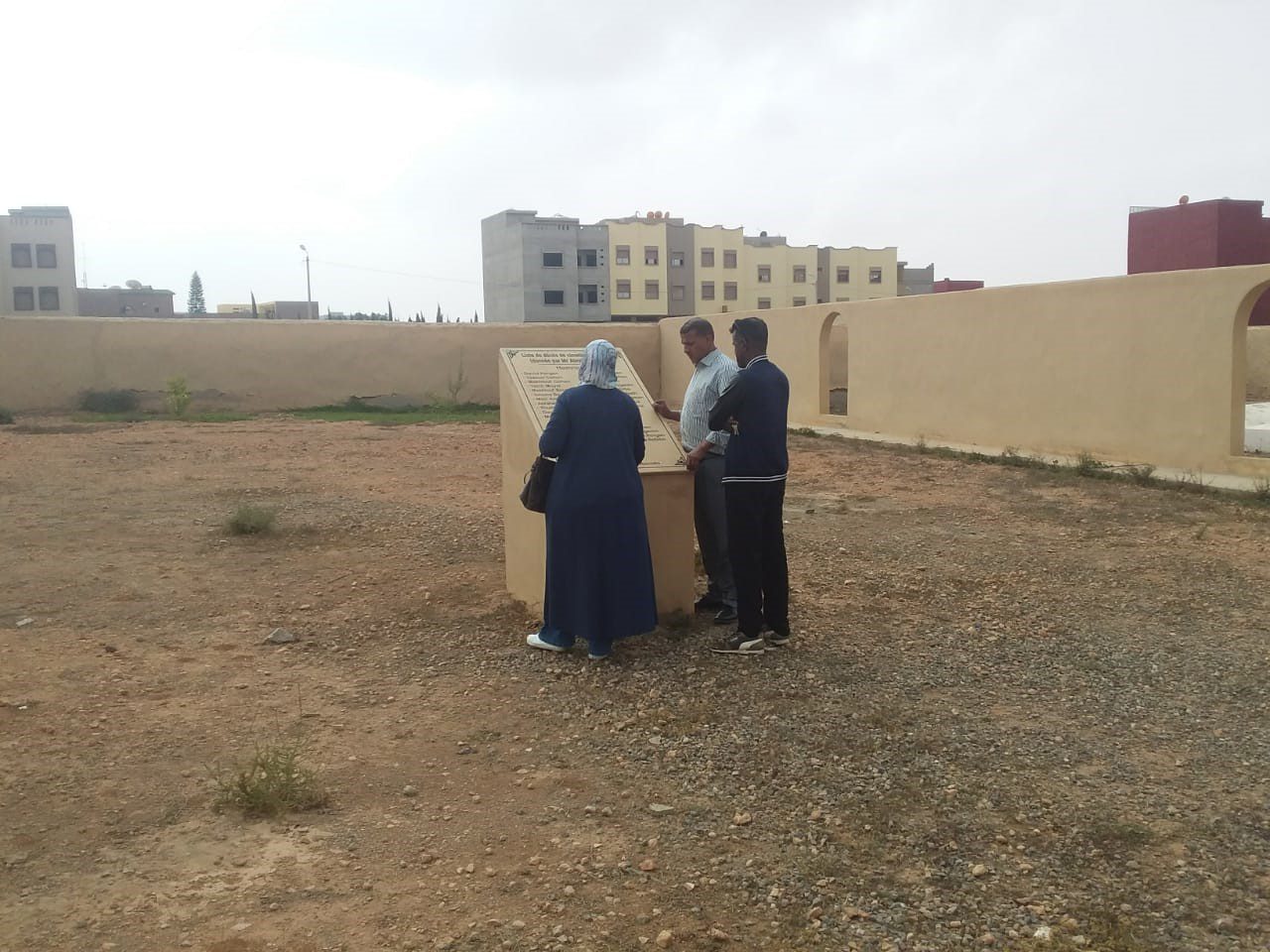Jamal Maghiouzi, Dakira Cultural Coordinator
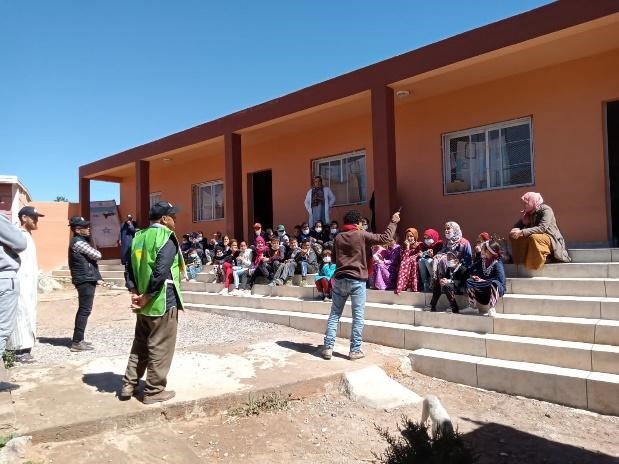
Early in March, I had the opportunity to co-lead, alongside Youssef Tahiri from HAF’s tree team, cultural, environmental, and social activities for the students of Mohamed Elchaikh primary schools in the villages of the Tisfane rural commune. The members of the Tisfane community and its civil society contributed to the success of the activities, which were aimed at introducing and discussing local history and the subject of climate change as well as planting trees and distributing olive trees to the students.
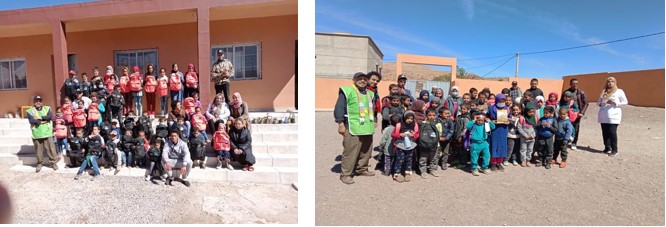
Mohmed Elchaikh Primary School in Ait Makhlouf and Isourg villages,Tisfane, Taroudant. Photo: Jamal Maghiouzi/HAF
During our activities, we facilitated an interactive workshop about the local history and cultural identities of the communities in Tisfane, notably, the tribe of the Ida Ouzdout, the Shurafa (descendants of the Prophet Mohamed), the Igourramne (those that are believed to have a “miracle” that can bless people), and Jewish people. The latter did not have a mellah in the tribe of Ida Ouzdout, but local people met them in the markets and in the villages as they travelled from one place to another to sell their products.
Jewish silversmiths, wood workers, saddle makers, and candlesticks makers are also part of this community and locals often hosted them if they were to spend more time in their villages. When it came to selling and buying, Jewish merchants accepted exchanging their goods for local products like honey, almonds, rugs and even old products. In the case that the locals did not have products to exchange with the merchants, they would also accept late payments. Thus, friendship, solidarity, and mutual respect were the highlight of Jewish-Amazigh relations in the Ida Ouzdout homeland.
Afterwards, Youssef tackled the topic of climate change and explained its causes, consequences, and solutions, including one HAF promotes in planting trees in order to reduce pollution.
Before demonstrating how to plant a tree, I talked about how drought can affect core community values. For example, members of the community used to support each other during agricultural activities throughout the year when there was extra production. This is called Tiwizi in Amazigh. Not only that, but locals also no longer welcome their guests the same way they once did by serving them Amlou made of Argan or almond and olive oil. In addition, they are unable to give other members of the family and those in need a share of their crops. This is why it is important for us to plant trees as it will help to revive those core communal values and preserve the planet for future generations.
From time to time, Bahsi El Youssefi, representing Tigmi n Turg Association for Development and Preservation of the Environment , elaborated on the traditional education of young girls and boys in the Ida Ouzdout community and its social organizations. In every school, one of the members of the association gave to teachers a book titled The Tribe of Ida Ouzddout, the Space and the Memory by Mohamed Moustaoui and Abd Ellah Kiker, which mentions the Jewish people of the area. We encouraged the students to borrow it from their school whenever they would like to learn more about their communities and their homeland.
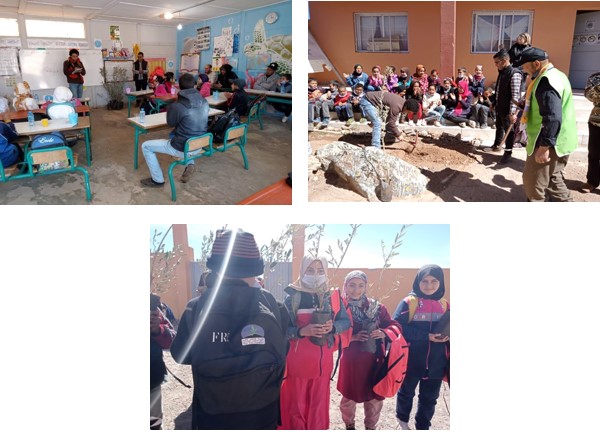
Mohamed Elchaikh Schools in Cimid village, Ait Makhlouf and Isourg villages,Tissfane, Taroudant. Photo: Jamal Maghiouzi/HAF
Every time we leave a school, we become prouder and prouder of the young generation because of their willingness to learn more about local history and take care of their environment. We are also proud of their teachers who are working hard to prepare them for a better future. It is up to us to help the younger generations learn about their past and to support them in building this better future.
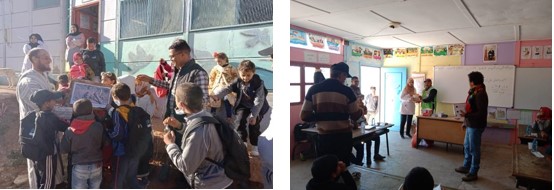
(Left) Abd Elhakim, President of Tagounit Association for Development and Solidarity and the students of Mohamed Elchaikh school in Cimid village give a framed photo to HAF’s Youssef Tahiri. (Right) Abd Ellah of Tigmi n Turg Association for Development and Preservation of the Environment distributing a book titled “the Tribe of Ida Ouzdout, the Space and Memory” for students to read, Tisfane, Taroudant. Photo: Jamal Maghiouzi/HAF
Our activities covered Mohamed El Chaikh primary schools in the following villages: Ait Makhlouf, Isourg, Ighir n Islan, Cimid, Edindi, Taghaout, Idalen, Idint, Tabqqalt, and Agerd. One hundred and eighty students (80 females and 100 males), sixteen teachers (14 females and 2 males) and the school’s principal took part in the activities. The president of the local commune showed his support by attending the first day and providing transportation.
Civil society representatives who were present included Tigmi n Turg Association for Development and Preservation of the Environment, Tigmi Agricultural Cooperative, Tagounit Association for Development and Solidarity, Idaln Association, the parents’ associations in Tabqqalt, Idndi Association, Cimid Association for Development and Cooperation, and Taourirt n Cimid Association. The community of Tisfane welcomed such an initiative as they also aim at developing local communities, caring for the environment, and preserving the memory of local communities. In total, 215 individuals participated in the activities.

At the end of that week, I went to the weekly souk, or market, of Tisfane and met the students who participated in the activities. They told me they had planted the trees we gave them during the activity. Two of them introduced me to their mother, who seemed to appreciate the activities that we had conducted for her children and their peers in Isourg’s primary school.
Jamal Maghiouzi is a Dakira Cultural Coordinator and is currently based in Taroudant. The USAID Dakira program, implemented by the High Atlas Foundation and its partners, aims to strengthen inter-religious and inter-ethnic solidarity through community efforts that preserve cultural heritage in Morocco.
This article was completed with the support of the United States Agency for International Development (USAID), and the High Atlas Foundation is solely responsible for its content, which does not necessarily reflect the views of the USAID or the Government of the United States.

